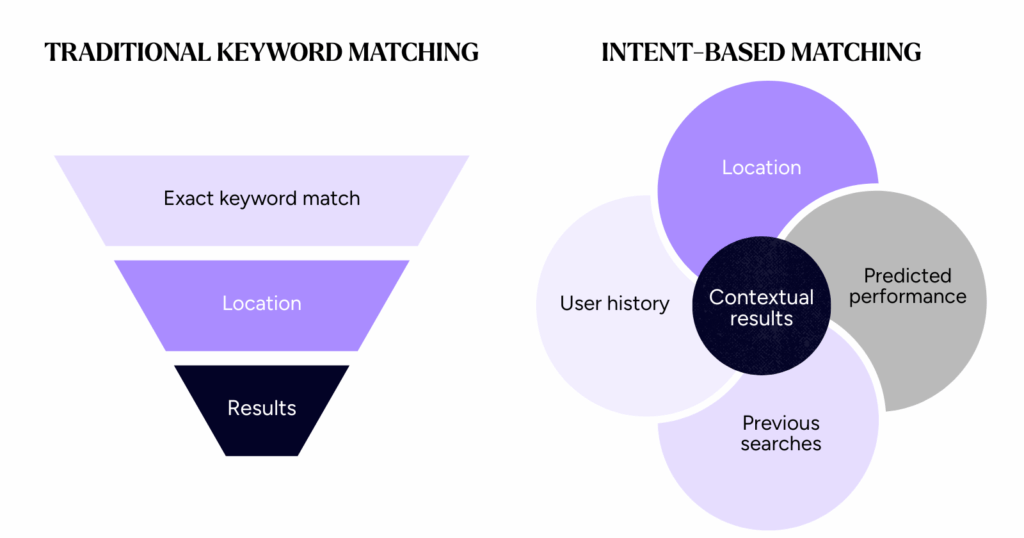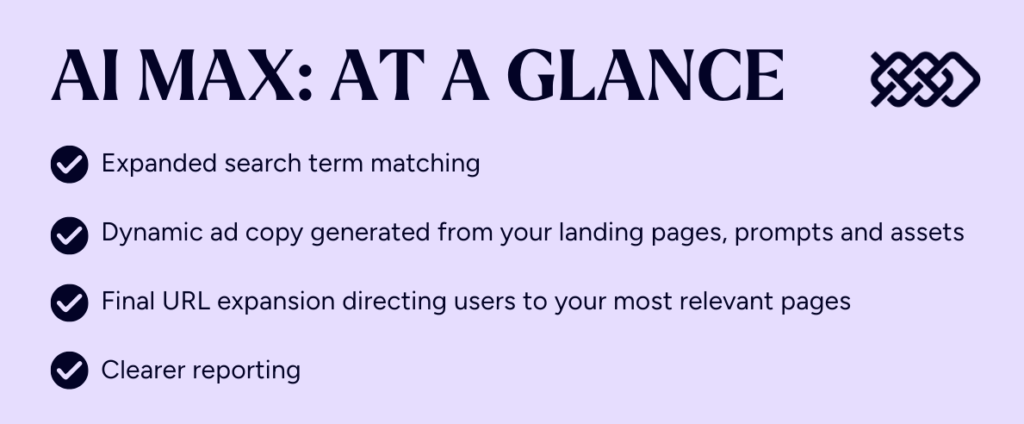The landscape of online search is undergoing a profound transformation, driven by the increasing sophistication of Artificial Intelligence. Google’s AI Max for Search campaigns are at the forefront of this shift, offering a comprehensive suite of AI-powered enhancements designed to keep campaigns competitive and addressing user needs.
Users are no longer limited to simple keyword queries – they’re engaging with search in more natural, conversational and multimodal ways. This evolution presents exciting new opportunities for advertisers to connect with potential customers at an unprecedented scale and level of relevance.
What is AI Max search?
AI Max for search is Google’s latest AI-powered enhancement for paid search campaigns.
Max is designed to expand reach and improve relevance without sacrificing advertiser control. Instead of creating a new campaign type, it layers automation onto existing setups by analysing intent, keywords and on site content to deliver more specifically tailored ads. Advertisers still manage budgets, match types and negatives, but AI integration aims to empower each campaign by suggesting new opportunities and ad copy.
Some key benefits of AI Max for paid media advertisers include:
- Expanded search term matching to capture relevant queries beyond your keyword list
- Dynamic ad copy generated from your landing pages, prompts and assets
- Final URL expansion that directs users to the most relevant page on your site
- Clear reporting that distinguishes AI Max performance from standard matches
“Early results suggest AI Max can result in stronger conversions and conversion value while maintaining Cost Per Action (CPA) or Return on Actual Spend (ROAS). However, careful negative keyword management is essential to avoid irrelevant traffic as the system learns more about your campaigns” – Westley Cogan
How is AI Max different from Performance Max?
AI Max for Search and Performance Max are both AI-driven campaign types in Google Ads, but they serve different purposes.
In contrast to AI Max’s aim of enhancing Search campaign viability, Performance Max is a fully automated campaign type that runs across all Google inventory (Search, Display, YouTube, Discover, Gmail, Maps) with minimal control over placement. AI Max is built for managing big budgets with high performance targets.
The rise of keywordless search and intent-based targeting
Keywordless search is a Google Ads approach where rather than manually adding keyword lists to their campaign, search advertisers upload their creatives and let Google’s AI match ads to relevant searches.
At the heart of the “keywordless future” lies AI Max for Search campaigns. This suite includes Search Term matching, a feature that goes beyond traditional keyword matching to find more relevant and high-performing search queries and conversions you might otherwise miss.
Instead of relying solely on the exact words users type, Search Term Matching uses intent-based technology. It analyses signals including:
- User history
- Location
- Previous searches
- Predicted performance
This shift is crucial as search queries become more nuanced and complex.
AI Max for Search campaigns also automatically activates asset optimisation settings, including text customisation (formerly known as “automatically created assets”) and final URL expansion. Text customisation generates tailored ad copy, such as headlines and descriptions, based on your landing page, ads and keywords. This combination ensures a hyper-personalised ad experience that aligns with user intent, in theory, increasing impressions, click-throughs and website actions.
According to Google’s own data, activating AI Max in Search campaigns typically leads to 14% more conversions or conversion value at a similar CPA/ROAS. For campaigns still heavily reliant on exact and phrase keywords, this uplift can be even higher, reaching 27%.

New ad opportunities in AI Overviews and AI Mode
The evolution of Google Search into more intelligent and conversational experiences, such as AI Overviews and AI Mode, is opening up entirely new commercial pathways.
- AI Overviews: These AI-generated summaries help users find information quickly for complex questions. They are globally available in over 200 countries and 40 languages, reaching more than 2 billion monthly users. AI Overviews provide a quick connection to relevant businesses through integrated text ads.
- AI Mode: Allows users to engage in a continuous conversation with Search, asking open-ended and follow-up questions. Early testers of AI Mode are asking significantly longer queries, approximately 2-3 times the length of traditional searches, indicating a deeper and more conversational engagement. Google is actively experimenting with showing ads both below and integrated directly into AI Mode responses.
These AI-powered Search experiences create more meaningful ways for businesses to connect with customers, and encourage an expanded user journey. For example, a search for “how to bring small dogs on a flight” might trigger a relevant ad for dog carriers after the initial question has been answered. Even if the user didn’t explicitly search for product recommendations, AI’s deeper understanding of their underlying commercial needs ensures users can continue their journey without an entirely new search.
To participate in these new ad opportunities, using AI-powered targeting solutions like AI Max for Search or Performance Max is essential.
Embracing multimodal search
Beyond conversational queries, search is also becoming increasingly multimodal, with voice and image searches in particular seeing a rapid rise in popularity.
Google Lens now processes over 20 billion queries a month, with 1 in 5 visual searches having commercial intent. Younger users, particularly Gen Z, are heavy adopters of Circle to Search, using it to initiate over 10% of their searches after trying it.
This shift means that advertisers need to be prepared to show up where discovery starts, regardless of the search input type. It underscores the importance of supporting text content with high-quality images and videos on your website to meet user preferences in this evolving environment.
By leveraging AI-powered solutions like AI Max for Search campaigns, advertisers can navigate the dynamic landscape of user curiosity, unlock new growth opportunities and ensure their businesses are visible in the moments that matter most to consumers. It’s a move away from rigid keyword matching to a more intuitive, intent-driven approach, delivering highly personalised ad experiences that convert.
The Challenges of AI Max
Of course, as with any search innovation, there are challenges and features that won’t work for your campaigns.
AI Max is tailor made for big campaigns and budgets, meaning it’s not ideal for managing campaigns with low conversion volumes, offering little additional insight. Search specialists setting up campaigns efficiently and effectively might not see much of a difference from Dynamic Search Ads.
AI Max might be most useful for specialists who have maxed out existing search activity and want to use it to find potential new keywords. As always, trusting in the experience and insights of paid media specialists who understand the ins and outs of your brand, delivers the best campaign results over long periods.

Prepare for a keywordless future with Loom
That felt like a lot, but that’s because there’s so much to say about AI Max! It’s a new tool and like any AI development we expect the way it works to shift and adapt over time. We’re evaluating AI Max’s evolution before implementing new search modes to reflect it. In the meantime, our priority is keeping our clients informed and their campaigns ahead of the curve.
Curious about Google’s new AI developments and eager to learn more about how it could impact your organic or paid media visibility? Get in touch with our team today for expert insights, advice and guidance on how we help businesses grow through cutting-edge Paid Media and Multi-Channel strategies.





